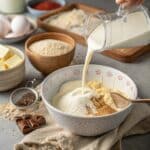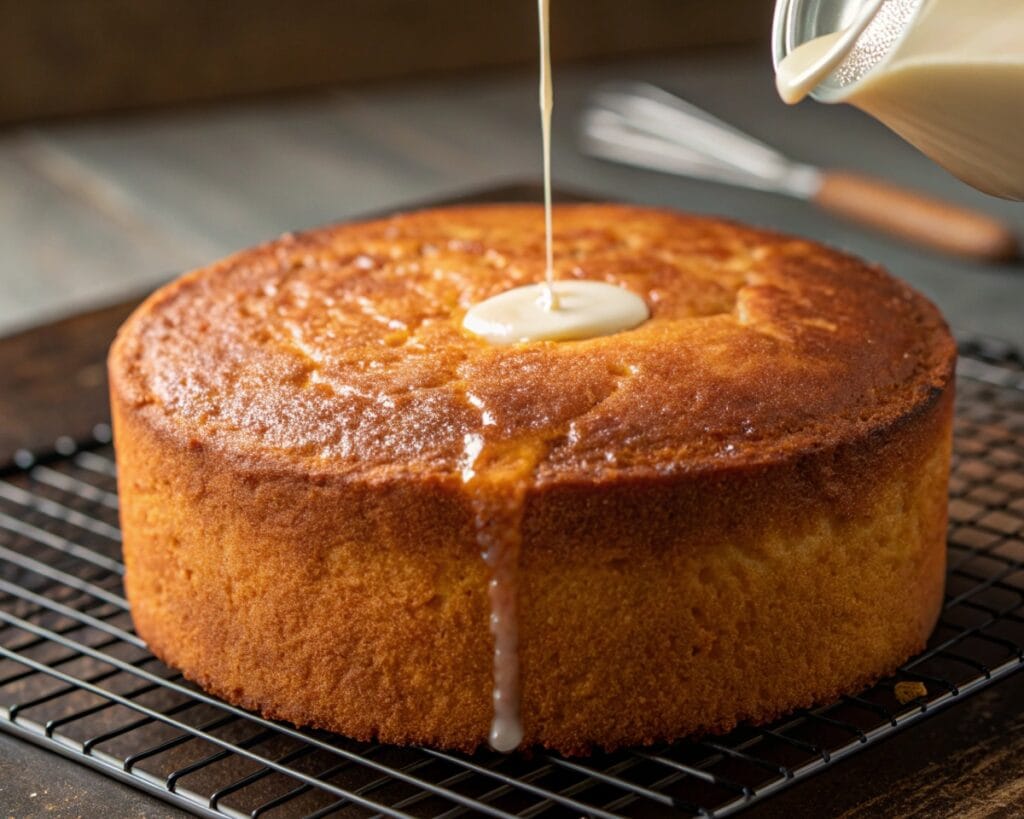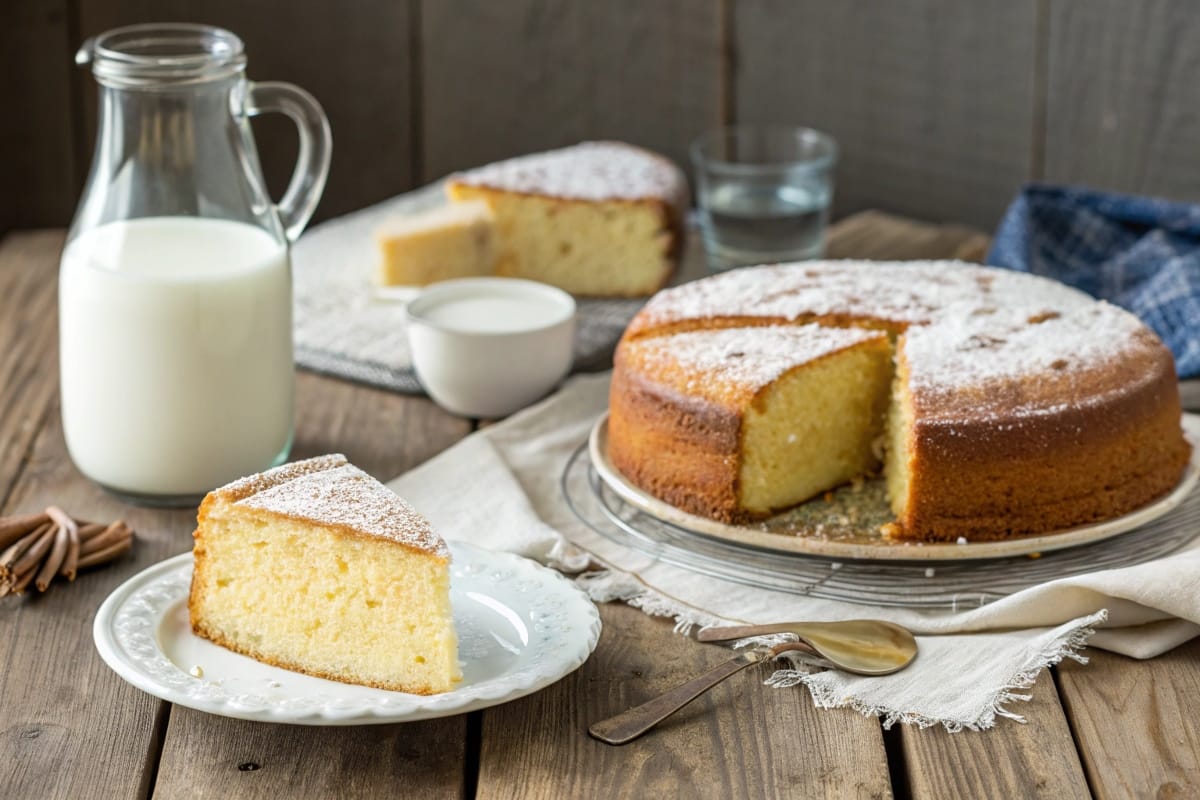Boxed cake mixes are a lifesaver for both seasoned bakers and beginners. But sometimes, you want to elevate that store-bought mix into something extra special. That’s where milk comes in! Substituting milk for water in cake mix is a simple change, but it can have a big impact on the final product.
In this guide, we’ll explore exactly what happens if I put milk instead of water in cake mix. From changes in texture to flavor enhancements, we’ll cover everything you need to know to bake a better cake. Let’s dive into Part 1 and explore why liquids are essential in cake mixes.
Print
Cake Mix with Milk
- Total Time: 35 minutes
- Yield: 1 cake 1x
- Diet: Vegetarian
Description
A quick and easy twist on boxed cake mix using milk for a richer, creamier texture and flavor.
Ingredients
- 1 box cake mix (any flavor)
- 3 large eggs
- 1/2 cup vegetable oil
- 1 cup milk (instead of water)
Instructions
- Preheat oven according to cake mix package instructions.
- In a large bowl, combine cake mix, eggs, oil, and milk.
- Mix until smooth and well combined.
- Pour batter into a greased cake pan.
- Bake as directed on the box or until a toothpick inserted in the center comes out clean.
- Cool before frosting or serving.
Notes
Using milk instead of water gives the cake a more homemade taste and added moisture.
- Prep Time: 5 minutes
- Cook Time: 30 minutes
- Category: Dessert
- Method: Baking
- Cuisine: American
Nutrition
- Serving Size: 1 slice
- Calories: 260
- Sugar: 20g
- Sodium: 300mg
- Fat: 11g
- Saturated Fat: 2g
- Unsaturated Fat: 8g
- Trans Fat: 0g
- Carbohydrates: 36g
- Fiber: 0g
- Protein: 3g
- Cholesterol: 35mg
Keywords: cake mix with milk, easy cake, boxed cake hack, moist cake
Table of Contents
Understanding the Role of Liquids in Cake Mix
Why Liquids Matter in Cake Batter
Liquids are fundamental in any cake mix—especially boxed mixes—because they activate and bind the dry ingredients. Water is commonly used because it’s simple, inexpensive, and readily available. But what exactly does it do?
- Hydration: Water moistens the dry ingredients, allowing components like flour, sugar, and leavening agents to blend and react properly.
- Structure Building: It helps create the right batter consistency, which directly impacts how soft, fluffy, or firm your final cake will be.
- Steam for Rise: As water heats up in the oven, it turns to steam, aiding in the cake’s rise and texture.
However, water only provides moisture—nothing more. That’s where many home bakers wonder: What happens if you use milk instead of water in cake mix ?
The answer: milk not only hydrates the mix but also adds richness, fat, and flavor, leading to a more decadent texture and a homemade taste that water alone can’t deliver. Choosing milk can elevate your cake from standard to sensational.
Comparing Milk and Water in Cake Mix
Substituting milk for water in cake mix introduces a range of changes. Unlike water, milk isn’t just a liquid—it’s packed with fats, proteins, and natural sugars that affect the cake in several ways:
- Fats: These add richness, making the cake’s texture softer and more tender.
- Proteins: Milk proteins contribute to a stronger crumb structure, giving the cake a balanced firmness.
- Sugars: Lactose, the sugar in milk, sweetens the cake slightly and enhances browning for a golden finish.
By swapping out water for milk, you’re not just hydrating the mix—you’re also enriching the flavor and texture. Ready to see how this plays out in your baking? In Part 2, we’ll dive into the specific effects milk has on your cake’s final outcome.

Effects of Substituting Milk for Water
HHow Milk Changes Cake Texture
What Happens If I Put Milk Instead of Water in Cake Mix? The most noticeable impact is in the cake’s texture. Unlike water, milk adds fat, protein, and natural sugars that transform a basic cake into something much more indulgent.
- Softer Texture: The fat in milk gently coats the flour particles, limiting gluten development. This results in a softer, more tender crumb that melts in your mouth.
- Moisture Retention: Thanks to its higher fat content, milk helps the cake stay moist longer, reducing the risk of it becoming dry or crumbly.
- Enhanced Crumb Structure: Milk’s proteins strengthen the cake’s internal structure just enough to support a light, fluffy rise without becoming dense.
It’s also important to consider the type of milk. Whole milk delivers the best results in terms of richness and texture, while skim or low-fat milk may produce a lighter but less creamy outcome.
Impact on Flavor and Appearance
When you swap water for milk, the flavor and appearance of your cake also take a delightful turn. Milk is naturally sweeter than water, and its sugars enhance both the taste and the browning process during baking.
- Enhanced Flavor: The subtle sweetness and richness of milk elevate the flavor profile of the cake, making it taste more homemade and less processed.
- Golden-Brown Finish: Milk sugars caramelize in the oven, giving your cake a lovely golden-brown crust. This is especially noticeable in vanilla and white cakes.
If you’re baking a chocolate cake, the creaminess of milk can make the cocoa taste even more decadent. For fruity cakes, milk helps balance tangy flavors with a touch of sweetness.
When Milk Might Not Be the Best Option
While milk works wonders in most cake recipes, it’s not always the ideal substitute.
- Dense Results: Using milk without adjusting the recipe’s fat content can make the batter too rich, resulting in a heavier cake.
- Recipes Requiring Lightness: Water is a better choice for recipes like sponge cakes, where a lighter texture is key.
Understanding these nuances will help you decide when milk is a smart swap and when sticking to water makes more sense.
Tips for Using Milk Instead
Adjusting Ratios for the Perfect Cake
What Happens If I Put Milk Instead of Water in Cake Mix? One key consideration is how milk changes the balance of ingredients. Milk introduces extra fats and sugars, which means a few adjustments are needed for best results:
- Reduce Additional Fats: If your cake mix already calls for butter or oil, slightly reduce those amounts to offset the fat content in the milk.
- Check Batter Consistency: Since milk is thicker than water, it can make your batter too dense. You might need to add a splash more milk or reduce the flour just a bit to keep the texture light and airy.
These small tweaks can have a big impact on your final cake’s texture and moisture.
Using Different Types of Milk
Still wondering, What Happens If I Put Milk Instead of Water in Cake Mix? It also depends on the type of milk you choose. Each variety brings its own flavor and texture:
- Whole Milk: Adds the most richness, fat, and moisture—ideal for decadent cakes.
- Skim Milk: A lighter alternative, though it doesn’t provide the same creamy result.
- Non-Dairy Milks: Options like almond, oat, or soy milk are great for dairy-free baking. Almond milk brings a mild nuttiness, while oat milk contributes a smooth, creamy mouthfeel.
Try experimenting with different types to discover what works best for your specific cake mix and personal preferences.
Best Recipes for This Substitution
Certain cakes benefit more from the richness and flavor milk provides. Here are some examples:
- Vanilla or White Cakes: Milk enhances their delicate flavors and creates a tender crumb.
- Pound Cakes: The added fat from milk complements their dense, buttery texture.
- Cupcakes: Milk ensures cupcakes stay moist and flavorful, even after frosting.
By keeping these tips in mind, you’ll be able to elevate any boxed cake mix with milk. Shall we move on to Part 4: Common Mistakes and How to Avoid Them?
Common Mistakes and How to Avoid Them
Overusing Milk in the Mix
One of the most common pitfalls when swapping water for milk in cake mix is overusing it. What happens if I put milk instead of water in cake mix but don’t adjust other ingredients? The result could be a heavy, dense cake.
- Why It Happens: Milk contains more fats and proteins than water, which can thicken the batter.
- How to Fix It: Use slightly less milk than the amount of water specified in the recipe. If the batter still seems thick, add small increments of milk or water until it reaches the right consistency.
Additionally, avoid doubling milk-based ingredients like butter or cream if they’re already in the recipe. Too much richness can overpower the cake’s flavor and texture.

Ignoring the Recipe’s Original Intent
While milk enhances most cakes, it’s not always the right choice. Cakes designed to be light and fluffy, such as sponge or angel food cakes, rely on water for their airy texture.
- Mistake: Using milk in recipes where water provides the desired lightness.
- Solution: Stick to water in recipes requiring a neutral liquid or where crispness is key, like in certain bread-like cakes.
If you’re exploring different recipes, check out our Easy Homemade Kefir Sheet Cake Recipe for an alternative take on enhancing cakes.
Want more details on this substitution? Check out our full guide on what happens if you use milk instead of water in a cake mix.
for more recipes follow us in facebook page or Pinterest
FAQs of “What Happens If I Put Milk Instead of Water in Cake Mix?”
Can I Use Flavored or Plant-Based Milk?
Yes! Flavored milks like vanilla almond or chocolate add a unique twist to cakes. However, keep in mind that these milks might change the cake’s taste significantly. Always adjust sugar levels in the recipe if the milk is sweetened.
For plant-based options, almond and oat milk are excellent choices. They mimic the creamy texture of dairy milk, making them perfect for most cake mixes.
How to Enhance Cakes with Milk
If you want to elevate your cakes further, try these tips:
Use whole milk or cream for richer flavors.
Add a splash of vanilla or almond extract to complement the milk’s creaminess.
For additional inspiration, explore our Red Velvet Cake Mix Cookies to see how other tweaks can transform your desserts.
Looking for more ideas? Check out What Happens If You Use Milk in Baking to see how similar substitutions can work in other recipes.
What happens if you use milk instead of water in a cake mix?
Using milk instead of water in a cake mix makes the cake richer and more flavorful. Milk adds fats, proteins, and natural sugars that enhance texture, creating a softer crumb and a creamier taste. However, it can make the cake slightly denser, so adjust other ingredients as needed.
What happens if you use milk instead of water in baking?
Substituting milk for water in baking generally improves the texture, flavor, and appearance of baked goods. Milk provides moisture, richness, and a touch of sweetness, which are ideal for cakes, muffins, and quick breads. That said, for recipes requiring a lighter texture, such as bread or sponge cakes, water might be a better choice.
What makes a cake more moist, milk or water?
Milk makes a cake moister than water due to its fat content. The fats in milk help trap moisture within the cake, preventing it from drying out. Additionally, milk proteins create a tender crumb, adding softness to the overall texture.
Dive deeper in our guide: What makes cake more moist: milk or water?
Why do you put water instead of milk in a cake?
Water is often used in cakes for its neutrality—it hydrates the batter without altering the flavor. It’s also a budget-friendly option for boxed mixes. However, water doesn’t add the richness or creaminess that milk provides, which is why many bakers prefer milk for a more indulgent result.
Conclusion
Wondering what happens if I put milk instead of water in cake mix? The answer is simple: your cake gets a flavor and texture upgrade. Milk adds richness, moisture, and a more homemade taste compared to water. While it may result in a slightly denser cake or affect shelf life, the overall improvement in taste and texture makes it a worthwhile swap. Whether you’re baking for a celebration or just want to impress with a better boxed mix, using milk is an easy trick that elevates your cake every time.

